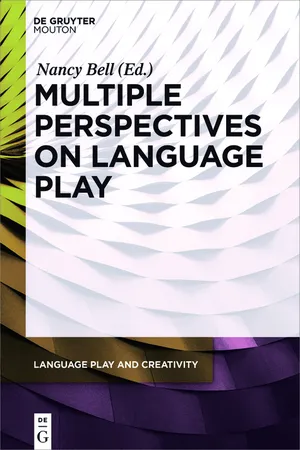1Introduction
Language play has been understood in two contrastive ways: first, language games with language as their object, and second, play with language as its medium. Language is clearly the object of play in games like crosswords, Scrabble and punning, where metalingual focus (Jakobson 1960) on the forms of language replaces the coherence of ordinary discourse. These language games may become serious business, for instance in the creation of concrete poetry and advertising slogans (see Crystal 1998). But language may also be the medium of play in teasing a friend or exchanging embarrassing personal anecdotes, where a play frame (Bateson 1953, Fry 1963) or a non-serious key (Hymes 1972) holds sway. Tannen speaks of talk framed by the meta-message ‘this is play’, parallel to the joking manner employed to ameliorate face threatening acts (Goffman 1955; cf. framing in Goffman 1974). Properly framed, even pointedly negative remarks can come across as playful sarcasm rather than serious aggression (see Boxer and Cortés-Conde 1997). But within the playful interaction, language may retain its literal meaning, as when friends flirtatiously pay each other compliments. Language play may include language games as such when conversationalists nonseriously frame their interaction as play and also transform the means and routines of everyday talk, as when the flirtatious compliments become obviously exaggerated, allusive or punning (see Straehle 1993).
Both language games and the use of language within a play frame are recurrent features of everyday interaction, and complete description of conversation should take both into account. Inasmuch as conversation is the natural home of punning and allusion, we understand these forms of humor only if we can explain their integration into everyday talk and their functioning in it. Consequently, an understanding of language games and language play in everyday conversation is a prerequisite for a complete account of verbal humor. This essay will begin with a survey of language games, then move into a consideration of language in a play frame with examples from genuine conversation to illustrate how the two coalesce and reinforce one another.
Language games and humor in everyday talk are based in interaction, demanding participation by the listener/recipient. They often involve gestures, playacting, and imitations of voices and dialects. Conversational language play often works from patterns of spoken interaction, taking the form of proverbial phrases, clichés, one-liners, allusions, stock responses and puns for recurrent situations which we pick up from and weave back into conversation; instead of initiating a conversation with a simple and humorless hello, we may choose from a repository of standard formulas such as we can’t go on meeting like this under appropriate circumstances. Again in taking leave, we may pass over the uncolored goodbye in favor of jocular stock phrases like see you in the funny papers. Besides these formulas for greetings and closings, conversationalists store and recycle humorous phrases tailored to bridge an uncomfortable pause or to wrap up an old topic and to segue into a new one like cat got your tongue? We have special formulas for effecting the transition from a joke or period of non-serious talk into a new topic, namely but seriously, folks and but all kidding aside.
Discourse and conversation analysis as well as linguistic pragmatics have contributed much to our understanding of how conversationalists fit jokes and puns into their ongoing talk, and how recipients react to them. Sacks (1973) discusses fortuitous puns in conversation. Sherzer (1978, 1985) extends Sacks in his investigation of both intentional, unnoticed and unintentional, purposeful puns. Norrick (1993) provided the first full-length study of conversational joking, including punning, teasing and narrative forms. Schegloff (1987) discussed a pervasive ‘joke-first practice’ in conversation, while Straehle (1993) explored teasing in conversation (cf. Boxer and Cortés-Conde 1997), Carter (2000) approached overstatement, punning and so on in conversation in terms of their creativity, Lytra (2009) has described teasing in the classroom, and Tsakona (2013) provides a look at word play in parliamentary speech. By contrast, research on language games proper has usually been based on written data, with few exceptions such as Opie and Opie (1959), the classic folkloristic study of children’s language games, and Cook’s (2000) treatment of children’s language games as competition and collaboration. Norrick (1984) explored formulaic conversational humor pragmatically, and there is significant work on language games from literary sources (e.g. Redfern 1984), specifically riddles (Dienhart 1999), puns in the press (e.g. Bucaria 2004) and on the internet (e.g. Seewoester 2011), while the study of actual practices of language games in natural conversation is largely anecdotal, but see Norrick (1988) on binomials and McCarthy and Carter (2004) and Norrick (2009) on hyperbole.
This chapter will illustrate both language games proper and creative language play and their convergence with examples from everyday conversation, and present ways of analyzing such interactions, particularly with regard to their significance for the organization of conversation, for our understanding of the forms of everyday talk, and for interpersonal relationships, especially concerning the interplay of humor and aggression. Section two just below begins with general ...
